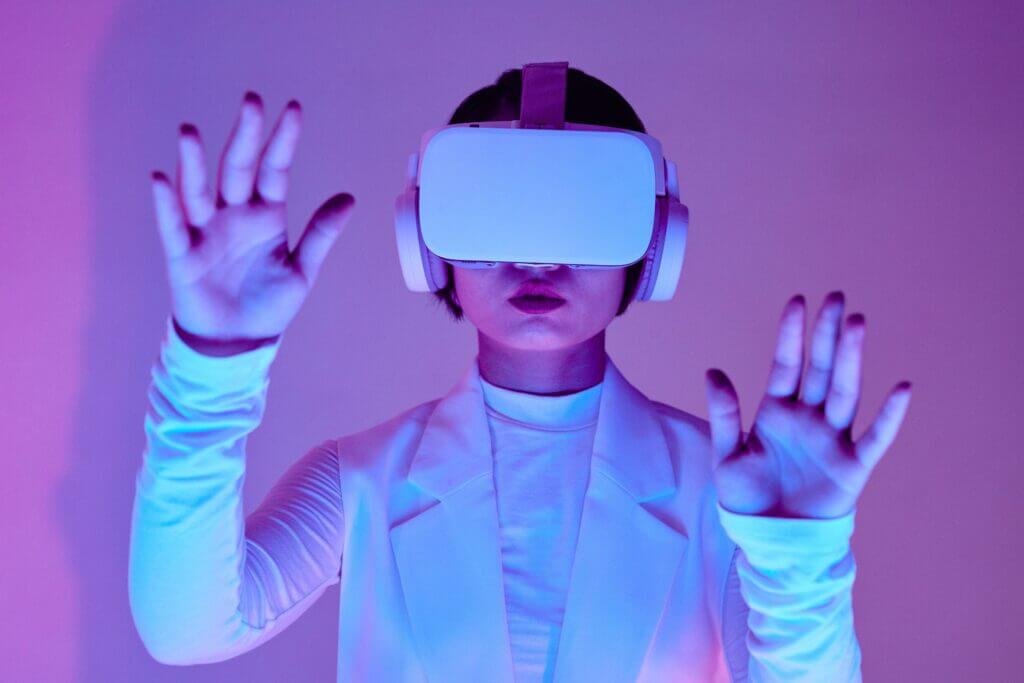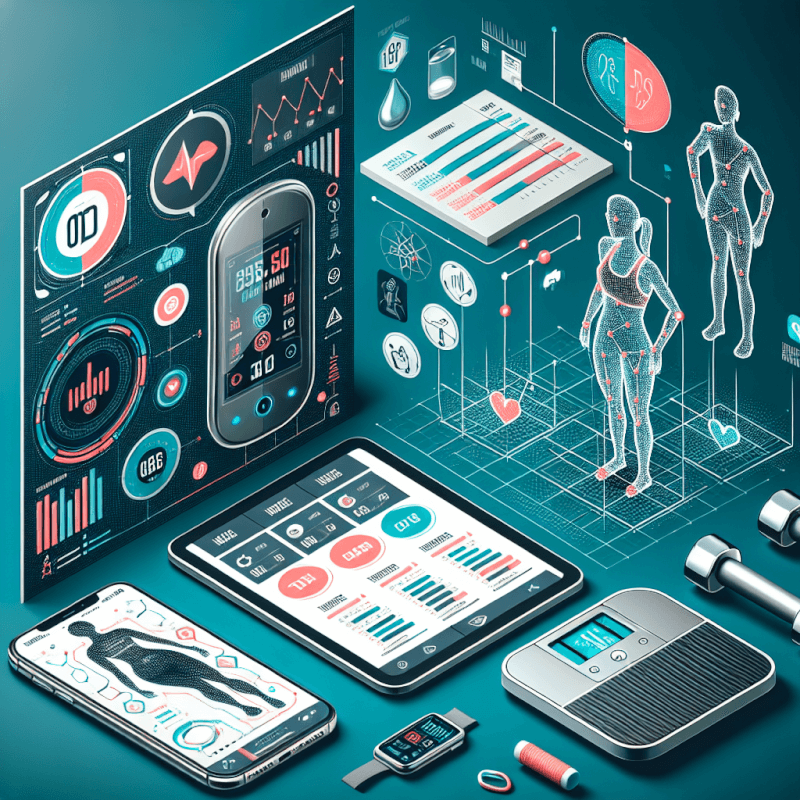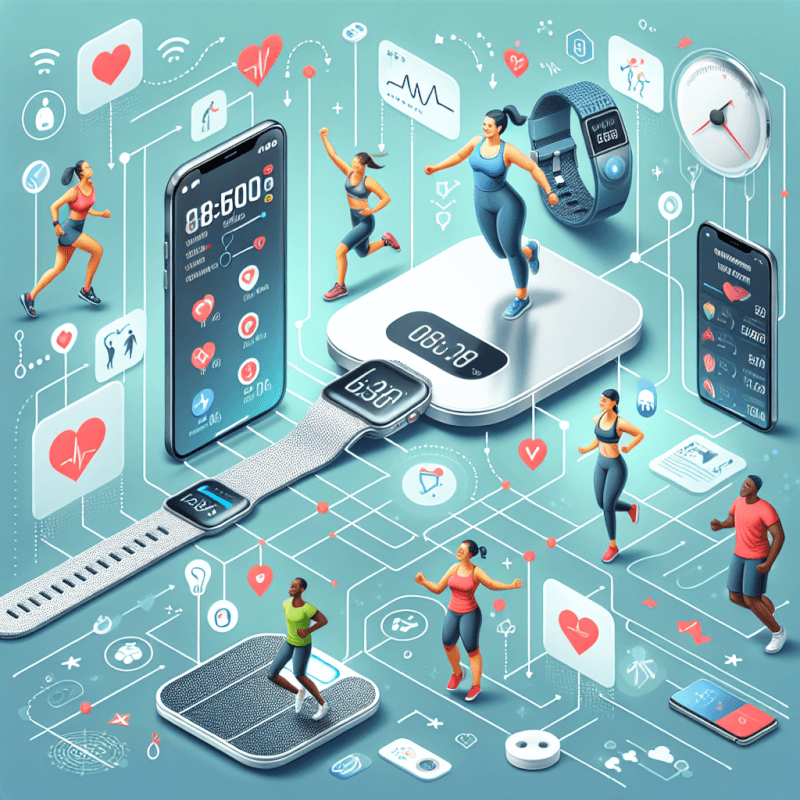Are you looking for ways to take your fitness and health routine to the next level? Well, look no further! In this article, we will explore how you can utilize the power of technology to enhance your overall well-being. From fitness wearables that track your every move to mobile apps that provide personalized workout plans, there is no shortage of innovative tools available to help you achieve your health goals. So, whether you’re a seasoned fitness enthusiast or just starting your wellness journey, get ready to discover the endless possibilities technology brings to your fitness and health routine.
Tracking Fitness Progress
Using Wearable Devices
Wearable devices have revolutionized the way we track our fitness progress. These small, portable devices are worn on the body and can monitor various metrics such as steps taken, distance traveled, calories burned, and even heart rate. They are equipped with sensors that collect data and sync it with smartphone apps or computer software, allowing you to keep a detailed record of your fitness activities. With a wearable device, you can easily track your progress over time and stay motivated to reach your fitness goals.
Fitness Apps and Trackers
In addition to wearable devices, there is a wide range of fitness apps and trackers available for smartphones and tablets. These apps allow you to track your workouts, set goals, and monitor various health metrics. Some apps even provide personalized workout plans and nutrition advice based on your fitness level and goals. Whether you prefer running, cycling, yoga, or strength training, there is a fitness app out there that can help you stay on track and achieve your fitness goals.
Setting Goals and Tracking Metrics
Setting goals is essential for maintaining motivation and measuring progress. Technology can help you set realistic goals and track your metrics to ensure you are on the right path. By inputting your desired weight, body fat percentage, or fitness level into a tracking app or device, you can monitor your progress and make necessary adjustments to your routine. This real-time feedback allows you to stay accountable and make informed decisions about your fitness and health journey.
Virtual Workout Options
Online Fitness Classes
Virtual workout options have become increasingly popular, especially in today’s digital age. Online fitness classes offer the convenience of working out from the comfort of your own home while still receiving expert guidance and instruction. Whether you’re interested in yoga, HIIT workouts, dance classes, or strength training, there are countless online platforms that offer a variety of classes for all fitness levels. These classes often provide live interaction with instructors and fellow participants, making it feel as though you’re part of a community even though you’re working out remotely.
Fitness Video Games
For those who enjoy a more interactive approach to fitness, fitness video games offer a fun and engaging way to stay active. These games utilize motion sensors in devices such as game consoles or virtual reality headsets to track your movements and provide an immersive workout experience. Whether you’re boxing, dancing, or engaging in virtual sports activities, fitness video games can provide a full-body workout while keeping you entertained and motivated.
Virtual Personal Training
If you prefer a more personalized approach to your fitness routine, virtual personal training may be the perfect option for you. With virtual personal training, you can work with a certified trainer from the comfort of your own home. Through video chat platforms or fitness apps, you can receive one-on-one guidance and tailored workout plans that are specific to your goals and fitness level. This virtual interaction allows your trainer to monitor your form, offer feedback, and provide the support you need to reach your fitness goals.

Monitoring Health Metrics
Smart Scales and Body Composition Analyzers
Monitoring your health metrics goes beyond just tracking your weight. Smart scales and body composition analyzers can provide a comprehensive picture of your overall health. These devices use advanced technology to measure factors such as body fat percentage, muscle mass, bone density, and even hydration levels. By regularly tracking these metrics, you can get a clearer understanding of your body composition and make informed decisions about your fitness and health routine.
Heart Rate Monitors
Tracking your heart rate during exercise is an effective way to gauge the intensity of your workouts and make sure you are in the appropriate target heart rate zone. Heart rate monitors can be worn as chest straps or integrated into wearable devices such as smartwatches or fitness trackers. These monitors use sensors to measure your heart rate in real-time and provide feedback on your cardiovascular performance. By monitoring your heart rate, you can optimize your workouts and ensure you’re getting the most out of your fitness routine.
Blood Pressure Monitors
Regular monitoring of your blood pressure is crucial for maintaining heart health. High blood pressure can increase the risk of heart disease and other health complications, so it’s important to keep it under control. Blood pressure monitors allow you to easily measure your blood pressure at home and keep a record of your readings over time. Some monitors even come with companion apps that provide insights and guidance on maintaining healthy blood pressure levels. By regularly monitoring and tracking your blood pressure, you can take proactive steps to improve your cardiovascular health.
Nutrition and Meal Planning
Food Tracking Apps
Proper nutrition plays a vital role in overall health and fitness. Food tracking apps can help you maintain a balanced diet by allowing you to log your meals and track your daily caloric intake. These apps often have extensive databases of food items, allowing you to easily search and input what you eat. They can also provide insight into the nutritional value of your meals, including macronutrient breakdowns and calorie counts. By consistently tracking your food intake, you can make more informed choices about your nutrition and ensure you’re fueling your body properly.
Smart Kitchen Appliances
Smart kitchen appliances, such as smart scales, smart blenders, and smart slow cookers, can simplify the process of meal planning and preparation. These appliances can connect to your smartphone or tablet via Bluetooth or Wi-Fi and provide real-time data and guidance. For example, a smart scale can measure ingredients precisely and send the information to a recipe app, ensuring accurate and consistent cooking. Smart blenders can provide personalized recipes and nutritional information based on your individual needs. These appliances make meal planning and preparation more efficient and enjoyable, taking the guesswork out of cooking healthy meals.
Meal Delivery Services
Meal delivery services have gained popularity as a convenient way to ensure nutritious meals are available, especially for those with busy schedules or limited cooking skills. These services deliver pre-packaged, portion-controlled meals directly to your doorstep. Many of these services offer customizable options to fit various dietary preferences and restrictions. By using meal delivery services, you can save time on meal planning and preparation while still enjoying healthy, balanced meals that support your fitness and health goals.

Sleep Tracking and Optimization
Smart Sleep Trackers
Getting quality sleep is essential for overall health and well-being. Smart sleep trackers can help you monitor your sleep patterns and make adjustments to optimize your sleep quality. These trackers are typically worn on the wrist, and they use sensors to monitor factors such as sleep duration, sleep stages, and even heart rate during sleep. By understanding your sleep patterns, you can identify potential disruptions and make lifestyle changes to improve your sleep quality, leading to better overall health and improved performance in your fitness routine.
Sleep Analysis Apps
Sleep analysis apps provide detailed insights into your sleep patterns and offer personalized recommendations for improving your sleep quality. These apps often integrate with wearables or can be used independently to track factors such as sleep duration, sleep efficiency, and even the quality of your sleep environment. Some apps also offer features like guided meditation, white noise, or relaxing music to help you relax and fall asleep more easily. By using sleep analysis apps, you can gain a better understanding of your sleep habits and make adjustments to promote better sleep quality.
Smart Pillows
Smart pillows are a relatively new innovation in sleep technology. These pillows are equipped with sensors that monitor your sleep patterns and provide feedback on factors such as snoring, head position, and sleep quality. Some smart pillows also offer features like built-in speakers for playing ambient sounds or gentle vibrations to promote relaxation and deeper sleep. By using a smart pillow, you can optimize your sleep environment and receive personalized feedback to help you improve your sleep quality and overall well-being.
Motivation and Accountability
Fitness Challenges and Competitions
Participating in fitness challenges and competitions can provide an extra boost of motivation and accountability. Many fitness apps and online platforms offer virtual challenges where you can compete against yourself or others to reach specific fitness goals. These challenges often come with built-in tracking features that allow you to monitor your progress and compare your results with others. By engaging in friendly competition, you can stay motivated, push yourself harder, and celebrate your achievements along the way.
Social Media Support Groups
Social media platforms have become a valuable tool for creating and joining fitness support groups. These groups provide a community of like-minded individuals who can offer guidance, motivation, and support throughout your fitness journey. Whether it’s through Facebook groups, Instagram accounts, or fitness-specific forums, social media can connect you with people who share similar goals and challenges. By actively participating in these support groups, you can find encouragement, share your progress, and gain valuable insights and tips from others who are on a similar path.
Gamification of Fitness
The gamification of fitness has transformed the way we approach exercise and goal-setting. Many fitness apps and devices incorporate gamification elements such as rewards, badges, and challenges to make workouts more engaging and enjoyable. These features can provide a sense of accomplishment and make exercising feel like a game. By turning exercise into a fun and interactive experience, gamification can increase motivation, adherence to a fitness routine, and overall enjoyment of physical activity.

Stress Management and Meditation
Meditation Apps
Incorporating meditation into your fitness and health routine can have numerous physical and mental benefits. Meditation apps offer guided meditation sessions that can help you relax, reduce stress, and improve focus. These apps often have various programs tailored to specific needs, such as stress reduction, better sleep, or enhancing mindfulness. By incorporating meditation into your routine with the help of these apps, you can cultivate a more calm and focused mind, which can positively impact your overall well-being.
Biofeedback Devices
Biofeedback devices provide real-time information about your physiological responses to stress and can help you develop strategies to manage it effectively. These devices, often worn on the wrist or attached to the body, measure metrics such as heart rate variability, skin conductance, and breathing patterns. By connecting to smartphone apps, these devices provide instant feedback and offer exercises or techniques to regulate your body’s responses to stress. By using biofeedback devices, you can develop a greater awareness of your body’s reactions and learn how to better manage stress for improved overall health.
Stress Tracking and Analysis
Stress tracking and analysis tools allow you to monitor and analyze your stress levels over time. These tools can range from smartphone apps to wearable devices with built-in sensors. They track key indicators of stress, such as heart rate, sleep quality, and physical activity, and provide insights into how these factors correlate with your stress levels. By recognizing patterns and triggers, you can make proactive changes to reduce stress and improve your overall well-being. Stress tracking and analysis tools can help you better understand and manage the impact of stress on your fitness and health routine.
Enhanced Personal Training
Virtual Reality (VR) Fitness
Virtual reality (VR) fitness offers an immersive and interactive workout experience. With VR fitness, you can engage in virtual environments and interact with digital trainers or fitness programs. These immersive experiences can make workouts more engaging and enjoyable, while still providing the benefits of a traditional workout. VR fitness can range from boxing and dance programs to full-body workouts that incorporate virtual reality headsets and motion controllers. By incorporating VR fitness into your routine, you can enhance your workouts and stay motivated to reach your fitness goals.
Biomechanics Analysis Systems
Biomechanics analysis systems provide a detailed assessment of your body’s movements during exercise. These systems use motion capture technology and sensors to analyze factors such as posture, joint angles, and muscle activation. By providing real-time feedback and analysis, biomechanics analysis systems can help you optimize your technique and prevent injuries. They can also be used to develop tailored exercise programs that target specific areas for improvement. By incorporating biomechanics analysis into your training, you can enhance your performance, prevent injuries, and achieve better results in your fitness routine.
Gait Analysis Tools
Gait analysis tools are specifically designed to analyze and improve your walking or running technique. These tools can range from wearable devices to smartphone apps. By measuring variables such as stride length, cadence, and foot strike, gait analysis tools can identify areas for improvement and offer feedback on how to optimize your gait. Improving your walking or running technique can help reduce the risk of injuries and enhance your performance. With gait analysis tools, you can refine your technique and make the most out of your walking or running workouts.

Injury Prevention and Rehabilitation
Virtual Physical Therapy
Virtual physical therapy has emerged as an effective way to prevent and rehabilitate injuries from the comfort of your own home. Through telemedicine platforms or video chat sessions, you can work with a certified physical therapist to develop personalized exercise programs and receive guidance on proper form and technique. Virtual physical therapy allows for regular check-ins and adjustments to your program, ensuring you stay on track with your rehabilitation or injury prevention goals. This convenient option eliminates the need for in-person visits and empowers you to take control of your recovery or injury prevention journey.
Recovery and Injury Prevention Apps
Recovery and injury prevention apps provide a wealth of resources and tools to help you manage and prevent injuries. These apps often include exercise libraries, mobility routines, and recovery techniques to target specific areas of the body or address common injuries. They can also provide educational resources and guidance on proper warm-up and cool-down protocols. By incorporating recovery and injury prevention apps into your routine, you can reduce the risk of injuries, speed up recovery, and optimize your performance in your fitness and health routine.
Wearable Injury Tracking Devices
Wearable injury tracking devices are designed to monitor and assess the risk of potential injuries. These devices use sensors to analyze factors such as impact forces, range of motion, and muscle activity. By providing real-time feedback, these devices can alert you to potential imbalances or excessive loading during your workouts. They can also offer recommendations for adjusting your technique or modifying your training to reduce the risk of injury. By utilizing wearable injury tracking devices, you can proactively prevent injuries and maintain a safe and effective fitness routine.
Healthcare Integration
Telemedicine and Remote Health Monitoring
Telemedicine and remote health monitoring have become increasingly popular ways to access healthcare services and monitor your health from the comfort of your own home. Through telemedicine platforms, you can have virtual appointments with healthcare providers, allowing for diagnosis, treatment, and monitoring of various health conditions. Remote health monitoring involves using wearable devices or smart home technology to track vital signs and health metrics, which can be remotely accessed by healthcare professionals. By integrating telemedicine and remote health monitoring into your routine, you can conveniently receive healthcare services and stay on top of your health from anywhere.
Medical Fitness Devices
Medical fitness devices are designed to bridge the gap between fitness tracking and healthcare monitoring. These devices are often FDA-approved and go beyond basic fitness tracking to provide more advanced health monitoring features. Some medical fitness devices can measure metrics such as blood glucose levels, EKG readings, or oxygen saturation. These devices can be valuable tools for individuals with specific health conditions or those who want to closely monitor their health. By incorporating medical fitness devices into your routine, you can have a more comprehensive understanding of your overall health and work towards achieving your fitness and health goals.
Health Data Sharing Platforms
Health data sharing platforms allow you to securely store and share your health information with healthcare providers. These platforms often integrate with various wearables, fitness apps, and medical devices, allowing for seamless transfer of health data. By utilizing these platforms, you can consolidate your health records, making it easier for healthcare professionals to access and analyze your data. This integration can improve the efficiency and accuracy of healthcare services and help you make more informed decisions about your fitness and health routine.
In conclusion, technology has transformed the way we approach fitness and health. From wearable devices and fitness apps to virtual workouts and stress management tools, there is a wide range of technology options that can enhance your fitness and health routine. By incorporating these technologies into your daily life, you can track your progress, stay motivated, prevent injuries, and optimize your overall well-being. Embrace the power of technology and take your fitness and health journey to new heights.



